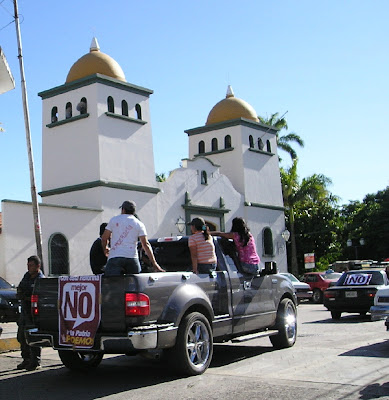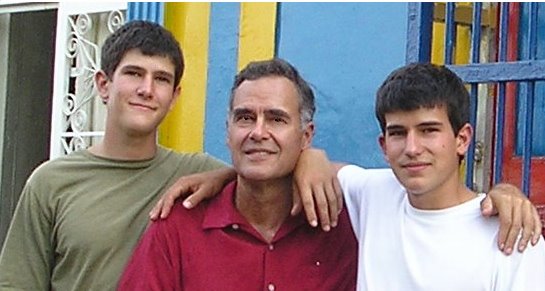 Friday, November 30, the Avenida Bolivar
Friday, November 30, the Avenida BolivarIt was late in the afternoon, the sun was about to set, and President Chavez was addressing the huge crowd that stretched up the Avenida Bolivar in Caracas. I had just waded through this sea of red, pushing through the tightly packed, happy crowd that extended down side streets and into neighboring parks. It was estimated that at least 500,000 people showed up, including 15 of us from Monte Carmelo and about 50 other people from nearby Sanare. We had left the State of Lara on two buses at 10 p.m. the previous night and arrived in Caracas early Friday morning. The fiesta atmosphere and the enthusiasm of the huge crowd made us think that the constitutional reforms would surely be passed in the election on December 2nd.
 Even the dogs were reds, and they were celebrating.
Even the dogs were reds, and they were celebrating.Why is there no photo here showing that the Avenida Bolivar was also filled with people on the previous day, November 29?
Because we weren’t there and the government was trying to ignore the protest. The political opposition was able to assemble a very large crowd in the same place the Chavez supporters would be the next day. They did not bring out 500,000, but quite possibly 200,000 or more, an impressive number for an opposition that had been divided and ineffectual for a long time.
Shortly before I took my photo on November 30 of the pro-Chavez, pro-reform gathering, I bumped into a friend in the crowd who happens to live in an apartment high above the Avenida Bolivar. He told me that from his vantage point he could see that the opposition had filled the avenue the previous day. He wasn’t pleased to see the sizable crowd, since he has worked very hard for several years on behalf of the Bolivarian Revolution. But he also wasn’t happy that the Venezuelan government television stations chose not to show the kinds of expansive panoramic views that would reveal the size of the march marshalled by their opponents.
On the other hand, long-range photos of the opposition march were given a prominent place in The New York Times and other media sources outside and inside of Venezuela, since they regularly play up events critical of Chavez and tend to ignore the Bolivarian Process itself. But this doesn’t mean that the government television and news outlets should do the same thing on behalf of their side. I’m not suggesting that neutral coverage was possible, but I think the Venezuelan people, and especially those who supported the constitutional reforms, needed to know more about the depth and strength of the opposition forces.
Possibly, if the Chavistas were armed with this information, they would have been able to prevail upon their neighbors - especially Chavez supporters in the barrios who abstained from voting in large numbers - to vote “Si” at the polls. Furthermore, the incident illuminates the need for more criticism within the Chavista movement, whose ‘to the barricades’ attitude about the revolutionary process often keeps them from engaging in a thorough evaluation of where they are going.
While this embattled attitude is understandable, given the constant barrages of vitriol and misinformation coming from the private media outlets and the United States State Department, it is not helping the political process to mature. (See a very informative Spanish video about how foreign right-wing sources have been helping to manufacture the Venezuelan ´student movement´ at Chris Carlson´s Gringo in Venezuela website.)
Critical Support is Necessary
Within any political structure, it seems nearly inevitable that those who feel they have an overwhelming numerical advantage will try to use it to solidify their position and advance their goals quickly. Clearly, the Chavez government felt that, with an electoral victory of almost 2 to 1 in late 2006, it had sufficient power in 2007 to enact the Constitutional reforms necessary for proceeding toward socialism.
If the government had been correct in thinking that a 2 to 1 margin of victory was possible in December of 2007, then we would not be questioning its judgment – we who generally support the Bolivarian Process would still be celebrating in the streets and anticipating the first steps of putting the reforms into practice.
But given that the government lost a close 50/50 vote, and did not get the support of 3 million people who voted for Chavez a year earlier, it’s only right that people question the content of the reforms and the way they were presented to the Venezuelan people.
Wider discussion of the reforms and other issues
In our little corner of Venezuela, Monte Carmelo, 303 campesinos voted in the election on December 2, more or less the same number that had voted in December of 2006. This meant that abstentions were not a factor here, as 255 voted for the reforms and 46 against. Nine more people voted against Chavez in this election, not a very large defection to the opposition.
Local voters are not ignorant or uninformed people, for they had engaged in spirited discussion of the reforms, grumbled about too much complexity and vague language, and then continued their tradition of supporting Chavez. But in a discussion with various neighbors last night, I found that they were ready to press ahead and try to pass some version of the constitutional reforms sometime during the remaining five years of Chavez’s term. This time it will be an effort that begins at the grassroots, gets discussed at length, and is brought to a national vote by means of a petition signed by 15% of the voters nationwide.
Some people in Monte Carmelo think that all the reforms are useful, but that some of them ought to be simplified as part of new education campaign that will reach the 20% of voters who voted in 2006 but abstained this time. Others expressed the opinion that no more than twenty or thirty reforms, rather than sixty nine, should be presented. According to one person it was important to select only the constitutional articles that are key to restructuring the government for a democratic socialist future. Another had a more gradualist view, thinking that the number should be limited to those that would pass easily now, while waiting a few years to push the more controversial articles.
Who knows? Maybe the people of Monte Carmelo will produce their own list of reformed reforms.






 “See,” replied Carmen as she turned to me, “we can live together in friendship even though some of us are with the Bolivarian Process and some are against it.”
“See,” replied Carmen as she turned to me, “we can live together in friendship even though some of us are with the Bolivarian Process and some are against it.”













